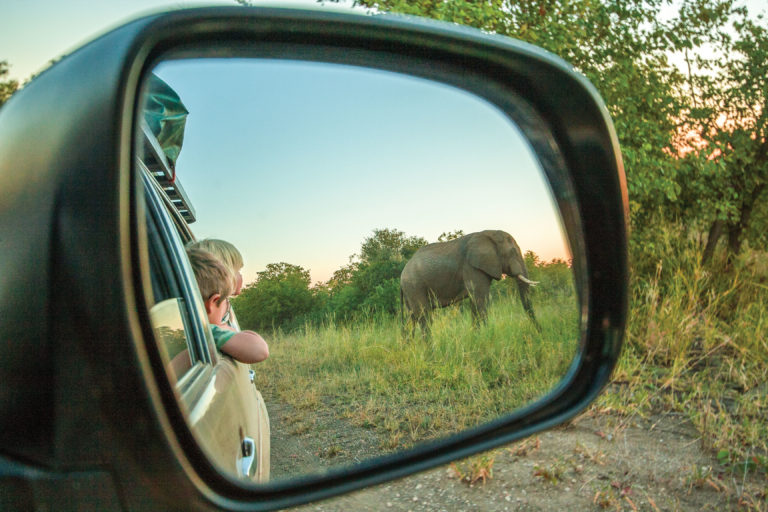The Kruger National Park is a part of the South African psyche. It’s a space that defines our country – a national treasure. Established in 1898 to protect the wildlife of the Lowveld, today Kruger is a world leader in advanced environmental management. Occupying two climatic zones and 16 distinct eco-zones, the park is home to an unrivalled abundance of life forms: 336 tree species, 49 fish, 34 amphibians, 114 reptiles, 507 birds, and 147 mammals.

Image: Catherine Hofmeyr
The size of Belgium, the game reserve is a place in which to lose yourself, driving for days through an African Eden. This is the realm of baobabs, leadwoods and fever trees; a land patrolled by the Big Five, the Little Five (buffalo weaver, elephant shrew, leopard tortoise, ant lion, and rhino beetle) and the birding Big Six (ground hornbill, kori bustard, lappet-faced vulture, martial eagle, Pel’s fishing owl, and saddle-billed stork). The founding fathers, Oupa Kruger and Uncle Stevenson-Hamilton, made a grand investment and we are the lucky inheritors. But the park is not a blank slate or untamed wilderness. It’s managed, fenced, controlled and is subject to fashions and politics. How could it be otherwise in this crazy country of ours?
The 20th century saw the park pass through three phases: the unfenced rule-of-the-wild under its first warden, James Stevenson-Hamilton; the order and regimentation of the Nationalist years; and, post-1994, a new vision for a highly diversified people’s reserve.
When I was a child my father used to take me to ‘The Park’. It was almost a rite of passage, a sacrament with age-old rituals lovingly administered. Sunset at the baptismal font (waterhole), breaking bread together (the braai) and moments of revelation (the spotted cat up close). There were gospels and teachings. Like learning how to see. As a boy I was blind – I’d look at a koppie and see only a koppie. Dad taught my eyes to stroke the hillside for the flick of a tail. Once my eyes were rewarded, blessed even, they never forgot.
The Kruger is different things to different people. For some, it’s boisterous kids in the back seat, queues at the shop, burnt meat – and fingers – and obsessive game campaigns with a wish-list that needs ticking. But the sooner you get over the cat count, relax into the silence and feel the wilderness, the better your experience. That’s when big mammals are merely a bonus.
In the ‘new’ Kruger, there are so many diverse experiences that allow you to get in touch with its nature, history and culture. For instance, 4×4 routes, golf at Skukuza, bush braais and museums. You can explore a Late Iron Age site, a 19th-century trading store or 18th-century iron-smelting works. There’s even the opportunity to hear a chamber orchestra in the wild.
The 21st-century Kruger is all about expansion. On 22 November 2018, Acting Minister of Environmental Affairs Derek Hanekom approved the 10-year Kruger National Park Management Plan, a giant step forward in the ongoing initiative to extend Kruger’s conservation footprint across borders and to incorporate a wide spectrum of landowners and land uses. It kick-starts the emergence of the 10-million-hectare Great Limpopo Transfrontier Conservation Area as a world-leading conservation initiative. No plan is perfect, but in time the less savoury items (such as trophy hunting and elephant-back riding) will no doubt be removed from the proposal, thanks largely to the work of dedicated activists.
In this, our special Kruger issue, Chris Davies embarks on a family-reunion journey to the park’s northern reaches (page 50), Catherine Hofmeyr explores the popular south (page 68), while Harriet Nimmo presents alternative activities and behind-the-scenes action (page 76 & 82), including the current poaching struggles. In the spirit of Greater Kruger, Michelle Hardie visits nearby Sábiè Game Park in Mozambique and Keri Harvey looks at the latest developments in Zinave National Park (page 88).
Enjoy our bumper Kruger issue!
You may also like
Related Posts
Justin Fox talks climate change, 50 years of Earth Day and how to live a...
read more
When visiting popular tourist spots nowadays, you can’t help but encounter the selfie stick. These...
read more
Justin Fox expounds on the sublime beauty of the Drakensberg, reflecting on pilgrims past and...
read more